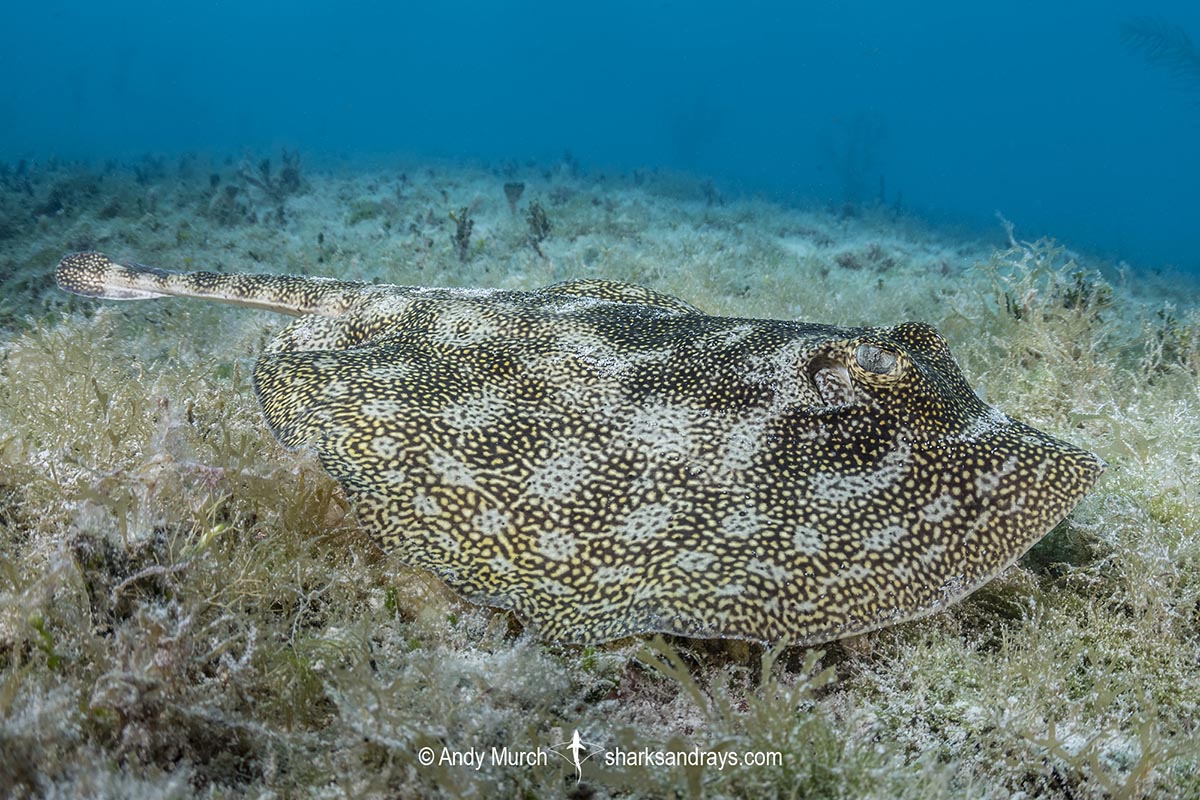Common names
Yellow Stingray, Yellow Spotted Stingray, Yellow Round Ray.
Binomial
Urobatis jamaicensis.
Synonyms
Raia jamaicensis, Trygonobatus torpedinus, Urobatis sloani vermiculatus, Urolophus jamaicensis.
Identification
A large round stingray with a sub-circular disc that is approximately longer than wide. Snout bluntly angular. Anterior margins of disc almost weakly convex, apices evenly rounded. Disc without thorns but with a narrow medial denticle band. Pelvic fins broadly rounded, length greatly exceeding width.
Eyes large; orbit length 0.47-0.55 x snout length. Mouth weakly arched. Nasal curtain skirt-shaped. Nostrils slit-like.
Tail short and broad based, with lateral skin folds that form a long overhanging ridge. Tail short, length 48-52% of total length. Caudal sting short, set far back on tail, its length slightly longer than caudal fin. Caudal fin relatively short and high, with a high upper lobe and a bluntly rounded posterior margin.
Colour
Dorsal coloration variable. Often beige with a dense covering of small greenish yellow spots or reticulations. Clusters of spots form larger light spots or weak ocelli. A black form with small orange spots is less common. Ventrum variably greenish, brownish, or yellowish with small dark spots on disc margin and tail.
Colour variation appears to be a response to environmental conditions. I have only seen the black form once in a silty mangrove lagoon in Utila. Whereas, on the white sand beaches in the Cayman Islands, yellow stingrays are extremely pale with barely discernible markings.
Size
Total length 76cm. Length at birth approximately 6cm.

Conservation Status
LEAST CONCERN
The yellow stingray is under threat from habitat loss due to climate change as the species is dependent on coral reef and seagrass beds. It is also threatened by artisanal fisheries exploitation for food and for use as bait in parts of its range in some central American countries, but the population appears to relatively stable.

Habitat
Warm temperate / tropical seas. Shallow sandy bay near coral reefs, muddy lagoons, on reef rubble, and around seagrass beds. Usually in shallow water close to shore but recorded to 70m
Distribution
Western Atlantic. The yellow stingray is found from North Carolina to the Guyanas including the Caribbean island chain and Gulf of Mexico.
Reproduction
Aplacental viviparous. 2 litters of 2-5 pups yearly.
Diet
Small bony fishes and benthic invertebrates.
Behavior
Non-migratory. In the Cayman Islands, yellow stingrays move into the intertidal zone to feed during high tide.
Reaction to divers
Somewhat skittish but sometimes initially tolerant of divers and snorkelers if approached carefully.
Diving logistics
Yellow stingrays are abundant throughout much of the Caribbean. They can be observed virtually anywhere by snorkelling around the edges of inshore reefs.
The black form of yellow stingray (see notes on colour) is probably confined to silty, turbid lagoons. I came across this form while snorkelling in the mangrove at Oyster Bed Lagoon, next to Deep Blue Resort in Utila, Honduras.
What’s new
View our full list of updates
Similar species
No other intricately patterned urobatid rays occur in the western Atlantic.









